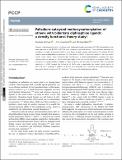Palladium–catalysed methoxycarbonylation of ethene with bidentate diphosphine ligands : a density functional theory study
Abstract
Catalytic methoxycarbonylation of ethene with a bidentate tertiary phosphine (DTBPX) and palladium has been explored at the B3PW91-D3/PCM level of density functional theory. Three different pathways for formation of methyl propanoate (MePro) have been studied, namely carbomethoxy (A), ketene (B) and hydride-hydroxyalkylpalladium pathways (C), the latter of which is favoured because it has the lowest overall kinetic barrier. After intermolecular methanolysis, a hydroxyalkylpalladium complex has been characterised on pathway C, which eventually leads to the low overall barrier to produce MePro. The possibility of copolymerisation leading to oligo-/polymers has also been considered. With a computed selectivity of >99% towards the formation of MePro and a reasonably low overall kinetic barrier of 23.0 kcal mol-1, pathway C appears to be the most plausible one. Consistent with experimental data, the overall barrier increases to 30.1 kcal mol-1 for a less bulky bidentate phosphine
Citation
Ahmad , S , Crawford , L E & Buehl , M 2020 , ' Palladium–catalysed methoxycarbonylation of ethene with bidentate diphosphine ligands : a density functional theory study ' , Physical Chemistry Chemical Physics , vol. Advance article . https://doi.org/10.1039/D0CP04454G
Publication
Physical Chemistry Chemical Physics
Status
Peer reviewed
ISSN
1463-9076Type
Journal item
Description
Authors thank EaStCHEM and the School of Chemistry for support.Collections
Items in the St Andrews Research Repository are protected by copyright, with all rights reserved, unless otherwise indicated.

